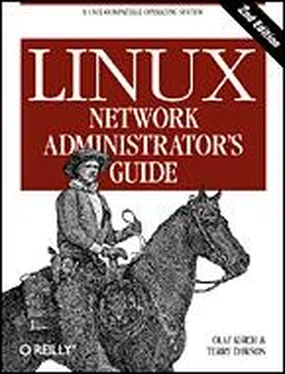The process for identifying whether a particular destination address matches a route is a mathematical operation. The process is quite simple, but it requires an understanding of binary arithmetic and logic: A route matches a destination if the network address logically ANDed with the netmask precisely equals the destination address logically ANDed with the netmask.
Translation: a route matches if the number of bits of the network address specified by the netmask (starting from the left-most bit, the high order bit of byte one of the address) match that same number of bits in the destination address.
When the IP implementation is searching for the best route to a destination, it may find a number of routing entries that match the target address. For example, we know that the default route matches every destination, but datagrams destined for locally attached networks will match their local route, too. How does IP know which route to use? It is here that the netmask plays an important role. While both routes match the destination, one of the routes has a larger netmask than the other. We previously mentioned that the netmask was used to break up our address space into smaller networks. The larger a netmask is, the more specifically a target address is matched; when routing datagrams, we should always choose the route that has the largest netmask. The default route has a netmask of zero bits, and in the configuration presented above, the locally attached networks have a 24-bit netmask. If a datagram matches a locally attached network, it will be routed to the appropriate device in preference to following the default route because the local network route matches with a greater number of bits. The only datagrams that will be routed via the default route are those that don't match any other route.
You can build routing tables by a variety of means. For small LANs, it is usually most efficient to construct them by hand and feed them to IP using the route command at boot time (see Chapter 5, Configuring TCP/IP Networking). For larger networks, they are built and adjusted at runtime by routing daemons ; these daemons run on central hosts of the network and exchange routing information to compute "optimal" routes between the member networks.
Depending on the size of the network, you'll need to use different routing protocols. For routing inside autonomous systems (such as the Groucho Marx campus), the internal routing protocols are used. The most prominent one of these is the Routing Information Protocol (RIP), which is implemented by the BSD routed daemon. For routing between autonomous systems, external routing protocols like External Gateway Protocol (EGP) or Border Gateway Protocol (BGP) have to be used; these protocols, including RIP, have been implemented in the University of Cornell's gated daemon.
We depend on dynamic routing to choose the best route to a destination host or network based on the number of hops . Hops are the gateways a datagram has to pass before reaching a host or network. The shorter a route is, the better RIP rates it. Very long routes with 16 or more hops are regarded as unusable and are discarded.
RIP manages routing information internal to your local network, but you have to run gated on all hosts. At boot time, gated checks for all active network interfaces. If there is more than one active interface (not counting the loopback interface), it assumes the host is switching packets between several networks and will actively exchange and broadcast routing information. Otherwise, it will only passively receive RIP updates and update the local routing table.
When broadcasting information from the local routing table, gated computes the length of the route from the so-called metric value associated with the routing table entry. This metric value is set by the system administrator when configuring the route, and should reflect the actual route cost. [16] The cost of a route can be thought of, in a simple case, as the number of hops required to reach the destination. Proper calculation of route costs can be a fine art in complex network designs.
Therefore, the metric of a route to a subnet that the host is directly connected to should always be zero, while a route going through two gateways should have a metric of two. You don't have to bother with metrics if you don't use RIP or gated.
The Internet Control Message Protocol
IP has a companion protocol that we haven't talked about yet. This is the Internet Control Message Protocol (ICMP), used by the kernel networking code to communicate error messages to other hosts. For instance, assume that you are on erdos again and want to telnet to port 12345 on quark , but there's no process listening on that port. When the first TCP packet for this port arrives on quark , the networking layer will recognize this arrival and immediately return an ICMP message to erdos stating "Port Unreachable."
The ICMP protocol provides several different messages, many of which deal with error conditions. However, there is one very interesting message called the Redirect message. It is generated by the routing module when it detects that another host is using it as a gateway, even though a much shorter route exists. For example, after booting, the routing table of sophus may be incomplete. It might contain the routes to the Mathematics network, to the FDDI backbone, and the default route pointing at the Groucho Computing Center's gateway (gcc1). Thus, packets for quark would be sent to gcc1 rather than to niels , the gateway to the Physics department. When receiving such a datagram, gcc1 will notice that this is a poor choice of route and will forward the packet to niels , meanwhile returning an ICMP Redirect message to sophus telling it of the superior route.
This seems to be a very clever way to avoid manually setting up any but the most basic routes. However, be warned that relying on dynamic routing schemes, be it RIP or ICMP Redirect messages, is not always a good idea. ICMP Redirect and RIP offer you little or no choice in verifying that some routing information is indeed authentic. This situation allows malicious good-for-nothings to disrupt your entire network traffic, or even worse. Consequently, the Linux networking code treats Network Redirect messages as if they were Host Redirects. This minimizes the damage of an attack by restricting it to just one host, rather than the whole network. On the flip side, it means that a little more traffic is generated in the event of a legitimate condition, as each host causes the generation of an ICMP Redirect message. It is generally considered bad practice to rely on ICMP redirects for anything these days.
As described previously, addressing in TCP/IP networking, at least for IP Version 4, revolves around 32-bit numbers. However, you will have a hard time remembering more than a few of these numbers. Therefore, hosts are generally known by "ordinary" names such as gauss or strange . It becomes the application's duty to find the IP address corresponding to this name. This process is called hostname resolution .
When an application needs to find the IP address of a given host, it relies on the library functions gethostbyname(3) and gethostbyaddr(3) . Traditionally, these and a number of related procedures were grouped in a separate library called the resolverlibrary ; on Linux, these functions are part of the standard libc . Colloquially, this collection of functions is therefore referred to as "the resolver." Resolver name configuration is detailed in Chapter 6, Name Service and Resolver Configuration.
Читать дальше



![Andrew Radford - Linguistics An Introduction [Second Edition]](/books/397851/andrew-radford-linguistics-an-introduction-second-thumb.webp)








